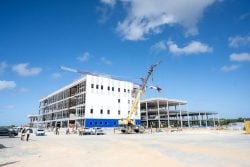“There is currently no scientifically accepted method or theory of earthquake prediction,” said David Oglesby, an associate professor of earth sciences at the University of California, Riverside.
Geologists have long been aware that a major earthquake could rock the fault line that runs through the Haitian capital, Port-au-Prince. The hard part was figuring out when.
U.S. geologists presented a paper in 2008 concluding that Port-au-Prince, which had not been hit by a major seismic event since 1751, could face a 7.2 magnitude earthquake.
But they could not say with any degree of accuracy if that quake would come the next day or in 30 years.
“There has been very little progress in area of actually predicting an earthquake, if by prediction what you mean is a specific date, size of the event and location,” Stuart Sipkin, a geophysicist at the U.S. Geological Survey, told Reuters in an interview.
“Where we are getting better is earthquake forecasting, where scientists are able to recognize what areas are likely to have a big earthquake sometime in the next several decades,” he said.
That forecasting is done by measuring the amount of stress built up in a particular fault, then extrapolating how much energy could ultimately be released.
Even then, the earthquake could strike at any number of points along a fault line, and evacuating people from one area ahead of a quake could put them right into harm’s way.
The paper presented in 2008 by geologists at the 18th Caribbean Geological Conference in Santo Domingo found that a 7.2 magnitude quake in a city like Port-au-Prince, with lax building codes and shoddy construction, could be catastrophic.
But Sipkin said that, from a seismological perspective, Tuesday’s 7.0 magnitude earthquake was not particularly unusual, or a sign of things to come.
He noted that on average about 16 to 18 magnitude 7 earthquakes strike per year, somewhere in the world, although most are in sparsely populated areas.
“At magnitude 7, despite the fact that there was so much devastation and the fact this was a disaster and a tragedy, this was a pretty run-of-the-mill earthquake (from a geological perspective),” Sipkin said.




